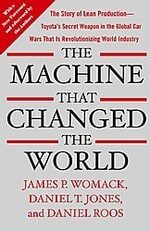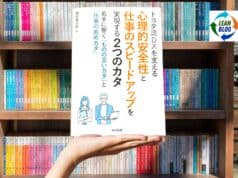Mark's note: Christina Kach is back with a new post, this time a review of what should probably be considered a “Lean classic.” Come back tomorrow for my first podcast interview with one of the co-authors, Dan Jones. You can find my previous podcasts with Jim Womack on the Lean Podcast main page. Maybe this will be the start of a “Belated Book Review” series. Let me know if you would like to review a “Lean classic” (or a book by Henry Ford, Frederick Taylor, etc.).

The Machine That Changed The World By James Womack, Daniel Jones, and Daniel Roos isn't a new title to those in the world of Lean. If we've not read it, we've certainly heard about it or seen it referenced in more than one book or lecture.
Taking public transportation to my new job gives me the opportunity to finally get some reading done on a long list of books I've been tagging on my GoodReads App. First up was this Lean classic and the following is a report on my thoughts and commentary about this hallmark book.
With a title so strong and tempting, and known to be the one that started it all, would this book deliver? I think it did, though not in the way I'd expected.
Going in, I expected this book to follow similarly to other Lean books I've read to date in my career. However, rather than reading as an informational textbook, with definitions, key words and concepts called out in bold, “Machine” reads more like a novel, where the authors narrate the stories of Toyota, their production system, and cultural norms. In a way, I'd compare it to a storyline you'd see in a History Channel special; examining the journey of the Toyota company through highs and lows, as well as a history lesson on other motor companies (a few of which no longer exist, reinforcing the points made here about the importance of being a problem solving company, constantly pursuing improvement rather than resting on laurels of past successes).
Overall, the book is about change; a 50/50 split of happy change embracing success stories and warning tales of resisting change. One such success story was a particular highlight of the book for me. Though already aware of the fact that Toyota worked closely with suppliers to improve their processes, in turn helping Toyota, the reminder was refreshing in a business world where secrecy is so prevalent. From recent conferences and learning on my end, I've seen an increase in the amount of information sharing around the Lean community. Whether that be businesses reaching out to help suppliers improve, or Lean practitioners sharing books and tips with others in industry (or, as a growing trend, even across industries), the message remains the same, let's help everyone succeed.
Another topic I found interesting was the discussions on the skills of craft production, which lead into mass production, which progressed into what we know today as “Lean” production. So, what's next? There was no answer given, as all was focused on Lean here, but in a way I suppose that is up to us to determine the future of processes and systems in every field whether it be service, manufacturing or healthcare.
Having been penned in 1990, there are moments that feel outdated. Though this is only because the world of Lean has continued to expand and develop, only strengthening these comments from 23 years ago. More than just that, it shows the 2013 audience that Lean isn't a mere fad, it is a way of being; one that was successful all those years ago and it still relevant today. One piece that didn't read as outdated was the section on obstacles that can block Lean application. It is interesting how some of the issues stunting Lean over two decades ago still affect us today.
As much as I enjoyed the historical take and review, I'm glad this was not the first Lean book I'd read. I believe I would have missed many of the key points and relevant information the book presented if I was not already aware of them from other books. While I do recommend this famous Lean novel as an addition to your reading list, if you are new to your Lean journey, I wouldn't suggest starting with this one. The Toyota Way by Jeffrey Liker or Lean Production Simplified by Pascal Dennis are better books for learning terms and definitions, which in turn will help you digest “Machine.” “
The Machine That Changed The World gave me a deeper appreciation for the roots of Lean, what we as Lean practitioners can contribute to our companies, and the importance of such work in our business environment. It reminds us that Lean didn't just appear, and can't just appear in our current worlds, it must be taught, grown, and nurtured continuously to be beneficial.
Christina invites you to connect with her via Twitter (@ChristinaKach) or at her blog for young professionals www.catchcareers.com.
What do you think? Please scroll down (or click) to post a comment. Or please share the post with your thoughts on LinkedIn – and follow me or connect with me there.
Did you like this post? Make sure you don't miss a post or podcast — Subscribe to get notified about posts via email daily or weekly.
Check out my latest book, The Mistakes That Make Us: Cultivating a Culture of Learning and Innovation:










Great post Christina. I completely agree with your comment about the Lean community being willing to share information and help each other. In Washington state government over the past 2 years, we’ve received pro-bono advice, training, coaching, and tours from 151 Lean experts from 60 different organizations. A little more than half of those experts are companies (not consultants/vendors) in Washington State who are using Lean to deliver value to their customers (like Boeing, Genie, Starbucks, Virginia Mason, Seattle Children’s, Alaska Airlines). Let’s all keep paying it forward!
That is so wonderful to hear! Not just the information sharing, but also government keeping an eye our for Lean application to their work. What type of work do you incorporate Lean into? I’m very interested to hear how Lean is being incorporated into government – cfkach (at) gmail {dot} com, would love to hear about how it is applied and some of the things you’ve worked on.
Great discussion. Lean, that is running efficient… that is providing the maximal service for amount of money spent is a very important systems procedural goal. It is also important ethically, resource utilization etc. However this must be in the context of the goal of providing the maximal level of service irrespective of cost. That is… what ever service is being provided is the goal. We must do that to 100 percent… many times that means spending more money than one woudl think is lean…rather than less. I guess what I am meaning is that the mission of any company should be first and foremost service to the client , this can be usually be accomplished in the context of efficient use of resources ( lean ) as well and the rest should all fall into place.
Yes… it’s a misnomer to think that “lean” means being cheap or not spending enough. That’s a problem that plagues the “Lean Startup” community, as well, not just Lean Manufacturing or Lean Healthcare.